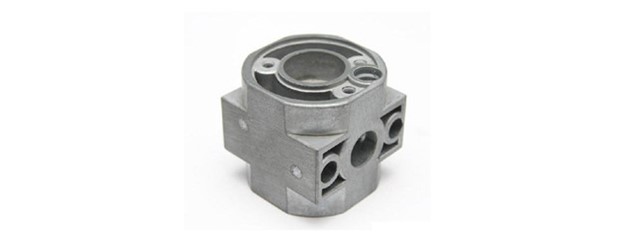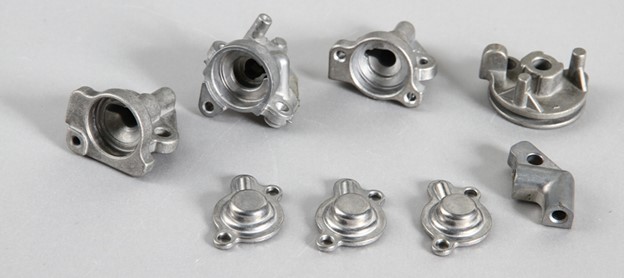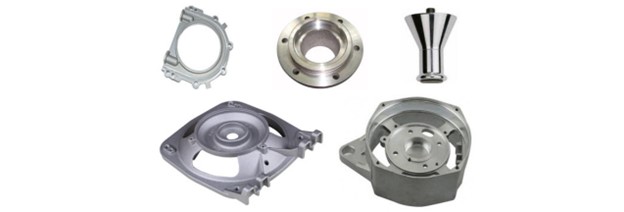Die casting is often categorized using the heat and pressure required to inject the molten metal into the die casting mold. However, the part manufacturing process is also categorizable based on the type of material, and zinc die casting is the most common in terms of part strength. This article talks about die-casting using zinc, its application, and its comparison with other materials.
What is Zinc Die Casting?

Zinc die casting is a process that involves melting zinc alloys (hence the name zinc alloy die casting) and injecting it into an already prepared die casting mold.
Zinc alloys are applicable in part manufacturing due to their ductility, impact strength, and low melting point. Furthermore, the casting process occurs under lower heat due to the material’s low melting point. Hence the name “hot chamber die casting process.”
Moreover, being a hot chamber process also promote the die’s longevity, time needed before retooling, and reduction in cost compared to other materials compatible with die casting.
Steps of the Zinc Die Casting Process
Generally, zinc alloy die casting is a hot chamber die casting process. While there are alterations in the process based on part size and machine types, there is also a general mechanism, as highlighted below:
Step #1: Preparing the Die
Clean the die-cast mold to remove impurities. Afterward, lubricate the die for better ejection of the casted part after cooling. Conclude step one by clamping the die with high pressure.
Step #2: Injection
Melt the zinc alloy and pour it into the injection machine’s shot chamber. Note that the shot chamber will be hot, as zinc casting is a hot chamber die casting. Afterward, inject the molten zinc material into the die-cast mold at high pressure.
Step #3: Cooling and Ejection
Allow the zinc to cool in the die-cast mold to take the mold shape. Unclamp the mold to eject the solid zinc casting out of the die.
Note: Ensure the casting cools and solidifies before ejection.
Step #4: Trimming
Alongside other finishing processes, trimming involves the removal of the excess metals that occurs due to die casting defects. Trimming is achievable using a trim die, saw, or other procedures.
Note: the trimmed zinc cast is recyclable and reusable.
Zinc Alloys for Die Casting
There are several zinc alloys for die casting. Each one has unique properties. For example, the Zamak 3 is the common zinc alloy for die casting because of its superb dimensional stability and a balance between the physical and mechanical properties. A summary of zinc alloy suitable for die casting includes:
Zamak 2
Zamak 2/Zinc Alloy 2/Kirksite is the strongest and hardest alloy in the Zamak family. As a result, it is applicable in casting parts that require high structural integrity. As a result, they are common materials in the automotive and mechanical sectors.
Zamak 3
Zamak 3/Zinc Alloy 3 is a popular zinc alloy with superb dimensional stability and castability. Aside from its physical and mechanical properties, it is compatible with several finishing options, including painting, chromate treatments, and plating.
Zamak 7
Zamak 7/Zinc Alloy 7 is a modified Zamak 3 with a lower magnesium content and impurities than other members of the Zamak family. As a result of its constituent, the Zamak 7 is applicable in making parts that require high castability and surface finish. Aside from that, it is very ductile.
ZA 8
ZA-8 is a zinc-aluminum alloy known for its high aluminum content compared to the members of the Zamak family. Unlike other ZA alloys, the ZA-8 is compatible with the hot-chamber die cast.
ACuZinc5
ACuZinc5 is known for its hardness, lubricity, and creep resistance. General Motors researched and developed it, and it is applicable in making parts requiring high structural integrity and used in hot conditions.
EZAC
EZAC is another zinc alloy compatible with hot chamber die casting. It has superior creep resistance, high hardness, and high yield strength.
ZA 27 – Zinc Aluminum
ZA-27, from its number, contains 27% aluminum. Hence, it contains a higher level of aluminum than the Zamak family. Due to the aluminum content, it is more lightweight, strong, and durable. Hence, it is also applicable in making parts with structural integrity.
At RapidDirect, we have several zinc alloys for casting and an in-depth understanding of their use. As a result, we can advise you on the right material for your project.
Advantages of Zinc Die Casting

Although die casting is compatible with several materials, zinc alloy die casting is popular due to its mechanical properties. For example, it is strong, tough, firm, and cost-effective compared to other alloys. Below are a few advantages of the process.
Easy Assembly
Like any other die casting process, the entire part is cast as a single unit. Therefore, assembling reduces.
High Precision With Thin Wall
Zinc alloys are strong compared to other alloys compatible with die casting. As a result, design optimization that calls for a reduction in the wall thickness can be put into place. Compared to materials such as aluminum, zinc can still exude structural integrity in such a case. Aside from that, lower material use reduces the die casting cost.
Better Mechanical Properties
Zinc alloys have an advantage over aluminum and magnesium based on mechanical properties such as strength and durability. This further improves their use in parts that require materials with high strength. Other mechanical properties include corrosion resistance, firmness, and toughness.
Cast Complex Geometries
Zinc’s excellent bearing and wear properties make it suitable to act as bushings for structures in motion. Furthermore, it is suitable for making parts with complex geometries due to its ability to form joints with other materials.
Longer Tool Life
Mold used in zinc die casting can last about ten times the aluminum die casting mold due to the zinc alloy’s less abrasive and lower melting point. As a result, there is a reduction in mold damage and an extension in the tool’s longevity. Furthermore, this reduces the cost of tooling compared to other materials.
Faster Production
Zinc alloys have a low melting point and require a hot chamber die casting process that occurs at high-pressure injection. This will increase the cycle rate more than other materials, such as aluminum (zinc alloy die casting has a cycle rate that is 150-200% higher than aluminum).
In zinc die casting, injection of the zinc into the die mold is direct. This is unlike aluminum die casting, which requires melting the aluminum in an external container before injection occurs. Also, the casting has a high solidification rate which further improves the number of parts produced and reduces the cost of casting.
Various Finishing Options
There are several finishing options suitable for die casting materials. Common finishing options for the material are included.
- Plating is suitable for improving the functional and aesthetic attributes of the die-cast zinc. Functional improvement can be an increase in corrosion resistance and durability.
- Powder coatings for die-cast zinc are more for aesthetic purposes due to the wide range of colors available. Aside from that, it produces a durable and uniform surface finish on the casted parts.
- Painting serves functional and aesthetic attributes. Like powder coating, they are mainly used for their functional color due to the various colors available. However, painting requires a shorter time and lower production costs, unlike powder coating.
Other finishing options suitable for working with zinc casts include electroplating, mechanical plating, and anodizing. Each one has unique attributes that determine the application of the finished part.
Disadvantages of Zinc Die Casting
Although it has advantages based on its strength and durability, zinc alloy die casting also has disadvantages. Below are a few disadvantages of the material.
Is Prone to Defects
The process has a high filling speed and rapid cooling. As a result, the gas discharge can be late, leading to defects such as pores. Furthermore, defects such as pores and blisters reduce the die casting quality. Aside from that, such castings should not undergo heat treatment as it can lead to damage.
Heavy Parts
Zinc die casting is stronger but heavier than materials such as aluminum. As a result, they are not suitable for making parts where lightweight is important. This is visible in the lesser use of the process in the aerospace industry.
Not Suitable for Small-Batch Production
Die casting has a high initial investment cost. As a result, they are majorly applicable in the mass production of parts. Due to the high die casting cost, they are not cost-effective for small-batch production.
Applications of Zinc Die Cast Parts

Zinc die-cast parts are applicable in several industries. For example, in the automotive industry, they are preferred in making interior and engine components due to their strength. Below are a few applications of zinc die-cast parts:
Automotive Industry
Zinc castings are applicable in making several automotive industry interior components. The material has a higher preference than aluminum due to its strength. Examples of automotive zinc alloy casting include bearings, steering, and brake parts.
Note: The Zamak 2 zinc alloy is the most preferred zinc alloy due to its hardness and strength.
Electronics
Zinc alloy casting is also applicable in making components employed in manufacturing electronic parts such as energy regulators, toggle switches, wall clocks, and ceramic-encased resistors. Here, dimensional stability comes into play. Hence, Zamak 3 alloy is the most appropriate for making electronic parts.
Home appliances
Zinc casting is suitable for making home appliances such as belts, furniture inserts, key chains, shoe buckles, door locks, and handles. Here, its strength and dimensional stability improve its use in home appliances.
Mechanical sector
Zinc alloy casting is also applicable in making parts of engines used in the mechanical sector. Here, properties such as creep resistance and hardness come into play. Hence, the material is more suitable than materials such as aluminum.
Conclusion
Zinc alloy die casting is the most common casting method for making strong and durable parts. If you need casted zinc parts, there is a need to understand the die casting process, which this article thoroughly discussed, and outsourcing to successful die casting services.
At RapidDirect, we provide custom zinc die-casting services to deliver high-tolerance and precision zinc parts at a competitive price and fast lead time. Our online quotation platform provides instant quotations with an automated DfM report on uploading your CAD files. Furthermore, you can manage your order and track the casting process until delivery!
FAQs
Zinc die-cast is stronger than most common non-ferrous alloys used in die casting. For example, zinc die casting alloys have approximately 2.5X yield strength than aluminum die casting alloys.
Zinc casting has high corrosion resistance. As a result, the zinc cast part will not rust even when used in corrosive environments.
No, it is difficult to weld zinc die cast due to their low melting point. However, using materials such as Super Alloy 1 will make welding the die cast part possible.


